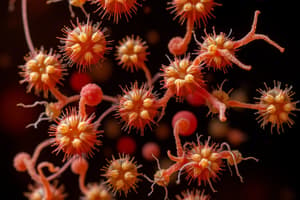Podcast
Questions and Answers
What type of microorganism is primarily responsible for yeast infections?
What type of microorganism is primarily responsible for yeast infections?
- Protozoa
- Viruses
- Bacteria
- Fungi (correct)
Which microbial group converts atmospheric nitrogen into a usable form for plants?
Which microbial group converts atmospheric nitrogen into a usable form for plants?
- Symbiotic Fungi
- Probiotics
- Decomposers
- Nitrogen-Fixing Bacteria (correct)
Which of the following is an example of a pathogenic protozoan?
Which of the following is an example of a pathogenic protozoan?
- Giardia lamblia (correct)
- Escherichia coli
- Aspergillus
- Candida albicans
In which relationship does one organism benefit while the other is neither helped nor harmed?
In which relationship does one organism benefit while the other is neither helped nor harmed?
Which group of microorganisms directly contributes to the carbon cycle through decomposition?
Which group of microorganisms directly contributes to the carbon cycle through decomposition?
What is a primary benefit of probiotics in human health?
What is a primary benefit of probiotics in human health?
Which type of cycle involves microorganisms that are essential for nitrogen transformations?
Which type of cycle involves microorganisms that are essential for nitrogen transformations?
What type of pathogen is specifically associated with foodborne illnesses?
What type of pathogen is specifically associated with foodborne illnesses?
Which of the following is an example of mutualism in microbial communities?
Which of the following is an example of mutualism in microbial communities?
Which of these is a consequence of the immune response to pathogenic microorganisms?
Which of these is a consequence of the immune response to pathogenic microorganisms?
Flashcards are hidden until you start studying
Study Notes
Pathogenic Microorganisms
- Definition: Microorganisms that cause disease in hosts.
- Types:
- Bacteria: Examples include Staphylococcus aureus (skin infections) and Escherichia coli (foodborne illness).
- Viruses: Examples include influenza virus (flu) and human immunodeficiency virus (HIV).
- Fungi: Examples include Candida albicans (yeast infections) and Aspergillus species (lung infections).
- Protozoa: Examples include Plasmodium (malaria) and Giardia lamblia (intestinal issues).
- Transmission: Can spread via air, water, food, vectors (like mosquitoes), and direct contact.
- Immune Response: Pathogenic microorganisms trigger responses which can lead to inflammation and tissue damage.
Beneficial Microorganisms
- Definition: Microorganisms that provide positive effects on health and environment.
- Types:
- Probiotics: Live bacteria that improve gut health, found in yogurt and supplements.
- Nitrogen-Fixing Bacteria: Convert atmospheric nitrogen into a form plants can use (e.g., Rhizobium).
- Decomposers: Break down organic matter, recycling nutrients in ecosystems (e.g., certain fungi and bacteria).
- Applications:
- Agriculture: Enhancing soil fertility and crop yields through biofertilizers.
- Food Production: Fermentation processes used in cheese, yogurt, and pickling.
- Biotechnology: Genetic engineering and producing enzymes for industrial use.
Microbial Ecology
- Definition: Study of microorganisms in their natural environments and interactions with each other and their ecosystems.
- Microbial Communities: Form complex relationships:
- Symbiosis: mutually beneficial relationships (e.g., gut microbiota in humans).
- Commensalism: one organism benefits while the other is unharmed (e.g., skin bacteria).
- Parasitism: one organism benefits at the expense of the other (e.g., pathogenic bacteria).
- Biogeochemical Cycles: Microorganisms play crucial roles in:
- Carbon Cycle: Decomposing organic matter and CO2 fixation through photosynthesis by prokaryotes.
- Nitrogen Cycle: Involves nitrogen-fixing, nitrifying, and denitrifying bacteria.
- Sulfur Cycle: Microbes involved in sulfur transformations, critical for nutrient cycling.
- Ecosystem Health: The balance of microbial populations affects ecosystem functions such as nutrient cycling and disease resistance.
Pathogenic Microorganisms
- Cause disease in living organisms.
- Bacteria, viruses, fungi, protozoa are examples.
- Spread via air, water, food, vectors, and direct contact.
- Trigger immune responses, which can lead to inflammation and tissue damage.
Beneficial Microorganisms
- Provide positive effects on health and the environment.
- Probiotics are live bacteria that improve gut health, found in yogurt and supplements.
- Nitrogen-fixing bacteria, like Rhizobium, convert atmospheric nitrogen into a form plants can use.
- Decomposers break down organic matter, recycling nutrients in ecosystems.
- Applications include agriculture, food production, and biotechnology.
Microbial Ecology
- Study of microorganisms in their natural environments and interactions with each other and their ecosystems.
- Microbial communities form complex relationships, including symbiosis, commensalism, and parasitism.
- Microorganisms play crucial roles in biogeochemical cycles.
- Examples include the carbon, nitrogen, and sulfur cycles.
- Ecosystem health is influenced by the balance of microbial populations.
Studying That Suits You
Use AI to generate personalized quizzes and flashcards to suit your learning preferences.




